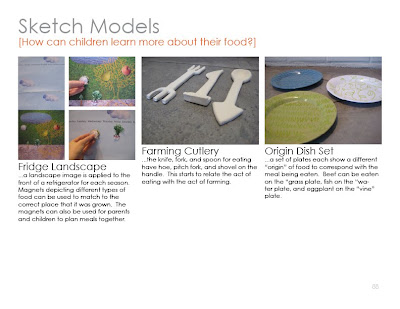




-matching most appropriate for 4-5 year olds.
-more exciting for parents than kids
-5-6 year old children start to “hord” and enjoy making patterns more
-likes menu planning idea because kids feel like they are “at their parent’s mercy” and do want to feel more included.
-some parents may not want to change eating habits for the whole family because of their child's request.
(Chika)
-loves the plates because they could be very memorable for the kids when they get older; she still remembers the plates she ate off as a child.
(Len)
-most excited about the refrigerator landscape
-think about the lifetime of the product...how long will the child be able to use it before they grow out of it. can the product evolve with them as they get older?
-think about how engaging the product it is after the first time it is used. does it get too boring too fast?
-how versatile is the toy?
-the pickin' playground does not have a very long lifetime and takes a lot of material to make that would just be thrown away after a year or so.
-the food storage is not present enough during times that they are not preparing food. the child should be able to engage with the toy whenever they feel they want to.
(Seth)
-kids really do want to participate in deciding what they eat and even what plates they eat from.
-plates could be a good idea, but we don't just eat one dish at a time. the plates need to be able to reflect different origins of food from the whole meal.
(psychology grad. student)
-it is around this age (3-6) that children start to be able to comprehend a representation of something (like an apple) to the real thing (eating a real apple)
-kids love having their own stuff ... like the plates!
-loves the farming cutlery
-menu planning portion of the refrigerator landscape could come with recipes with the same graphics for each ingredient.
-how should i deal with food that has multiple ingredients like bread?
-use birds and bee's model to see how to talk about animals/meat in a sensitive way.
-i may need to have a reference board to show all seasons of food.
(Samta)
-are the parents that need to be thinking about their food choices going to buy this product?
-is knowing that carrots come from the ground a deep enough story or connection to change their perception of food?
-loves plates
(David Lee)
-how will the kids learn how to match the food to the right plant? maybe color code?
-what about transitions between seasons?
-sticker book to label real food from store
-maybe needs instruction book for parents
1 comment:
Hi Leigh Ann,
You have done a ton of work, and I feel that you are inching towards a really thoughtful thesis project. Your strategy of rapid-fire ideation is a very good working process, and it usually leads to successful outcomes, in my experience. But, now that you have a large number of feasible project ideas, and given the depth of your research and your obvious command of the subject matter, you must make a choice and get busy fabricating and testing your product. I really, really like the cutlery as farm implements idea. Here's why:
1. It draws the connection more directly between our food and its origin.
2. Kids like to play with their food, and this gives them tools for doing that.
3. You can really explore the shapes through rapid prototyping or other methods.
4. It will be very easy to carry out user testing on these, because all you have to do is round up a bunch of kids, and sit them down with a plate of food, and then watch what they do. You can ask them questions to figure out if they know what the farm implements are, and explain how they are used. Then, you will be able to ask them questions to see if they get it.
Let me know if you agree. The key for you now is to make a rapid decision, then start making and testing stuff. Start now!
Steven
Post a Comment